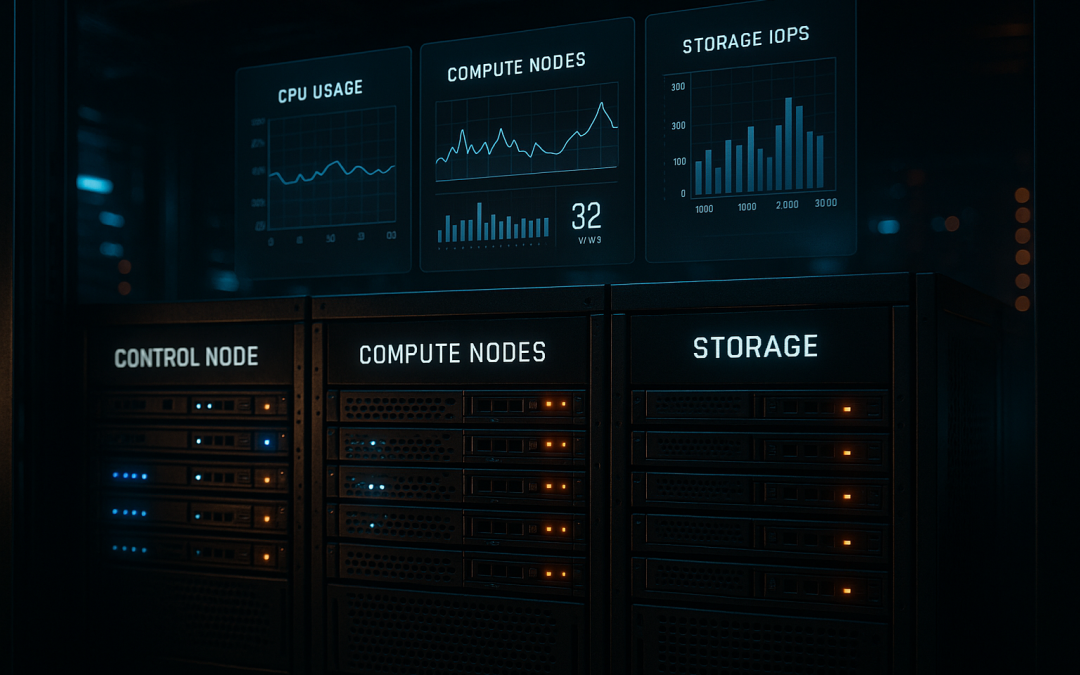Introduction
Building your own private cloud starts with selecting the right hardware. Unlike shared cloud resources, your on-prem infrastructure needs to be carefully tuned to support virtualization workloads—whether you’re running a handful of VMs or scaling hundreds of compute nodes.
In this guide, we’ll walk you through how to choose the best dedicated servers for hypervisors, compute, and storage roles—along with detailed specs, server role planning, and how dedicated server providers like vpszen.com fit into the equation.
🧱 Overview of Hardware Requirements for Hypervisors
Hypervisors are the foundation of any virtualized environment. Whether you’re using Proxmox, VMware ESXi, or XCP-ng, your physical servers must support:
🧠 CPU (Processor)
- Virtualization Support: Intel VT-x or AMD-V required.
- Core Count: More cores = more concurrent VMs.
- Minimum: 8 cores
- Ideal: 16–64 cores (depending on workload)
- High clock speed: Important for single-threaded performance (databases, CI/CD pipelines).
🧮 RAM (Memory)
- Most critical bottleneck in virtualization.
- Estimate 2–4 GB per light VM; 8–32 GB for high-performance workloads.
- ECC RAM preferred for stability.
- Min: 64 GB | Ideal: 128–512 GB (or more)
💾 Storage (NVMe, SSD, RAID)
- NVMe SSDs: Best for performance. IOPS are crucial.
- RAID Support: Hardware RAID with cache recommended.
- Storage Types:
- OS disk (RAID1)
- VM storage (RAID10 or ZFS pools for performance + redundancy)
🌐 Networking
- Dual 1 Gbps NICs (minimum); consider dual 10 Gbps for redundancy and iSCSI/storage backend.
- Support for VLAN tagging and trunking.
🧠 How to Structure Your Private Cloud
Divide your private cloud into distinct server roles for better scalability, fault tolerance, and performance:
| Role | Purpose | Hardware Focus |
|---|---|---|
| Control Node | Hosts Proxmox GUI, orchestration, dashboard | CPU, RAM, NVMe |
| Compute Nodes | Hosts VMs and containers | CPU, RAM |
| Storage Node | Centralized storage (ZFS, Ceph, NFS, iSCSI) | NVMe, RAID, RAM |
Each role can be run on dedicated servers or combined on small deployments.
🔍 AMD EPYC vs Intel Xeon for Virtualization
Choosing between AMD and Intel depends on your workload profile:
🔹 AMD EPYC:
- Higher core counts per socket (up to 96 cores)
- PCIe Gen 4/5 support (better for NVMe throughput)
- Larger L3 cache
- Better price-per-core ratio
- Preferred for large virtualization clusters
🔸 Intel Xeon:
- Mature ecosystem, more compatibility with some enterprise hypervisors
- Intel QuickAssist (QAT) for cryptographic acceleration
- Integrated graphics (for some models)
Verdict: AMD EPYC is typically better for raw performance and scalability; Intel Xeon is excellent for specific enterprise use cases.
🧰 Suggested Hardware Specs by Deployment Size
| Scale | Control Node | Compute Nodes | Storage Node |
|---|---|---|---|
| Small (5–15 VMs) | 8c/32GB/500GB SSD | 8c/64GB/1TB NVMe | Optional |
| Medium (20–50 VMs) | 12c/64GB/1TB NVMe | 16c/128GB/2TB NVMe | 16c/128GB/RAID10 SSDs |
| Large (50+ VMs) | Dual 16c/128GB | Dual 32c/256GB+ | High-density 32c/512GB w/ Ceph, NVMe pools |
All systems should have redundant PSUs, BMC/IPMI for remote access, and multiple NICs.
📦 Rack Planning & Networking
Rack Layout Tips
- Start with a 12U–24U rack for small deployments.
- Use 1U or 2U servers for density.
- Allocate:
- 2U – Control Node
- 6U+ – Compute Nodes
- 2U–4U – Storage
- 1U – Switch
- 1U – UPS or PDU
Networking Best Practices
- Use managed Layer 2/3 switches (supporting VLANs, QoS).
- Isolate networks:
- Management
- Storage
- VM Traffic
- Bond NICs (LACP) for redundancy and throughput.
- Plan for future expansion (spare ports, cabling routes).
💡 Why vpszen.com Dedicated Servers Are Ideal
If you’re looking for hardware designed for virtualization, vpszen.com offers:
- EPYC & Xeon-based dedicated servers optimized for hypervisors.
- NVMe-powered options for high IOPS workloads.
- Custom configs—choose RAM, storage layout, and bandwidth plans.
- Remote IPMI/BMC access for full server control.
- 24/7 support and data center redundancy in key global regions.
Whether you’re building a dev sandbox or an enterprise-ready private cloud, vpszen’s dedicated infrastructure ensures speed, uptime, and flexibility.
🛠️ Final Thoughts
Selecting the right hardware is foundational to your private cloud’s performance and longevity. Investing wisely in CPU, RAM, NVMe, and networking now ensures your infrastructure is scalable, stable, and ready for production.
Next up: Installing Proxmox VE—the open-source hypervisor we’ll use to power your cloud environment.

